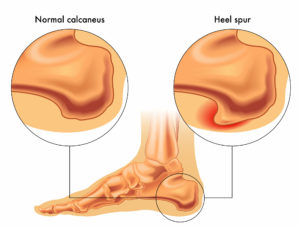Heel spurs are small calcium deposits that occur on the base of your heel bone. They usually are in conjunction with a condition known as plantar fasciitis. Heel spurs are not believed to  cause heel pain, although plantar fasciitis is more than likely the cause of the pain. Inflammation and irritation of the plantar fascia doesn’t usually develop overnight. Instead, it is most often a repetitive stress injury that can occur to anyone. Getting relief from the pain associated with heel spurs can sometimes require months of treatment with the proper shoes, orthotics and stretching exercises.
cause heel pain, although plantar fasciitis is more than likely the cause of the pain. Inflammation and irritation of the plantar fascia doesn’t usually develop overnight. Instead, it is most often a repetitive stress injury that can occur to anyone. Getting relief from the pain associated with heel spurs can sometimes require months of treatment with the proper shoes, orthotics and stretching exercises.
How to treat heel spurs
Cut back on your activity. If you are a runner, walker or just on your feet all day then it is important to back off on you speed and distance.
Ice your arches and heel spur. Ice the heel area for 10-15 minutes, moving the icepack around, and then wait at least an hour before icing again. Rolling your foot over a frozen bottle of water is a great way to reduce heel spur pain and plantar fasciitis swelling.
Proper shoes
When shopping for shoes you must look for the following: Firm soled shoes, a flexible or flimsy sole will allow to much stretching and pulling of the plantar fascia. Make sure your shoe has toe and heel rocker (see photo). Also, make sure the shoe has a firm heel counter and laces. Lace up shoe allow you to tighten the shoe properly and will help control pronation and supination.
Stretch your calfs. Always warm up before exercising. Stretching before any activity can greatly reduce the reinjury rate for heel spur pain and plantar fasciitis.
Use orthotics
Be sure to wear the orthotic in all your shoes, not just, your running shoes. Orthotics and arch supports are the best treatment for protection. The correct orthotic can reduce the stretching of the fascia, reload the weight bearing off of the painful heel spur and control pronation and supination. Thereby reducing or eliminating the pain altogether.
